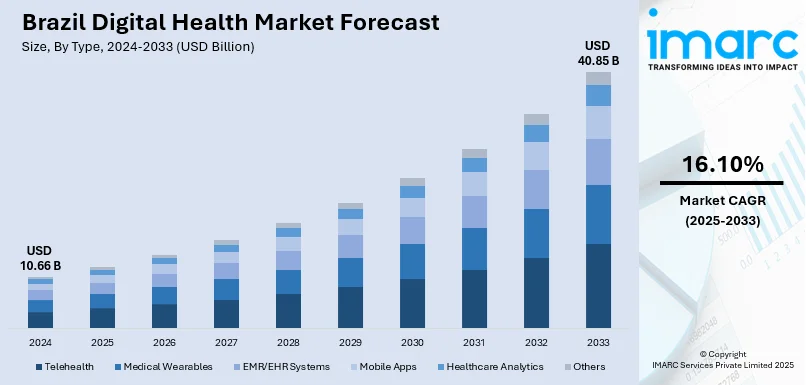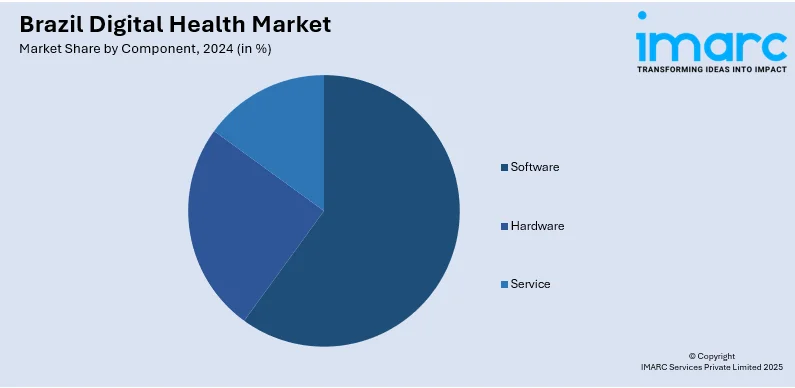
Brazil Digital Health Market Size, Share, Trends and Forecast by Type, Component, and Region, 2025-2033
Brazil Digital Health Market Overview:
The Brazil digital health market size reached USD 10.66 Billion in 2024. Looking forward, IMARC Group expects the market to reach USD 40.85 Billion by 2033, exhibiting a growth rate (CAGR) of 16.10% during 2025-2033. The growing reliance on smartphones for availing health management services online, government-led digital health initiatives that are enhancing telemedicine adoption and improving healthcare accessibility are some of the major factors positively impacting the Brazil digital health market share.
|
Report Attribute
|
Key Statistics
|
|---|---|
|
Base Year
|
2024
|
|
Forecast Years
|
2025-2033
|
|
Historical Years
|
2019-2024
|
| Market Size in 2024 | USD 10.66 Billion |
| Market Forecast in 2033 | USD 40.85 Billion |
| Market Growth Rate (2025-2033) | 16.10% |
Brazil Digital Health Market Trends:
Increasing Reliance on Smartphones
According to the Brazilian Institute of Geography and Statistics (IBGE), approximately 72.5 Million households in the country used the Internet in 2023, reflecting a penetration rate of 92.5%. This widespread accessibility is transforming the healthcare landscape, as more individuals are relying on their smartphones and online services for health management. The availability of affordable smartphones is enabling people to become more connected, which is increasing the adoption of digital health applications and platforms, which is positively influencing the Brazil digital health market outlook. As users are utilizing mobile devices for information and services, they are finding it easier to retrieve medical information, schedule appointments, and communicate with medical specialists from a distance. Telemedicine is also gaining traction as patients are seeking convenient ways to receive care without needing to travel long distances.

The shift towards digital platforms is allowing healthcare providers to reach underserved populations, improving access to essential services in the country. In addition, improving internet speeds are facilitating the streaming of high-quality video consultations and sharing of health data. The rising trend of health-related apps is enabling patients to monitor their conditions, track medications, and engage in preventive care. The increasing smartphone and internet penetration is encouraging innovations and improved patient engagement, which is offering lucrative growth opportunities to industry investors. This connectivity is also enriching the patient's experience by enabling seamless access to healthcare services and information, making the system more efficient and effective, thereby leading to better outcomes.
Government-led Digital Health Initiatives
Governing agencies of the country are recognizing the potential of technology to enhance healthcare delivery and promoting telehealth services and digital health solutions. Policymakers are accelerating efforts to integrate telemedicine into the public health system, ensuring that citizens have access to remote care. They are implementing supportive regulations that facilitate the use of digital platforms for consultations and prescriptions, thereby facilitating the Brazil digital health market growth. Therefore, in order to address patient requirements, healthcare practitioners are implementing telehealth services. These initiatives are also expanding coverage in underserved areas, where traditional healthcare access can be limited. By investing in infrastructure and improving Internet connectivity, governing agencies of the country are enabling more individuals to seek digital health services.
Besides this, public health campaigns are generating awareness about the benefits of digital health tools. Patients are engaging more with mobile health applications that help them manage their conditions and track wellness. For instance, the Latin American and Caribbean Center on Health Sciences Information and the Department of Monitoring, Evaluation, and Dissemination of Strategic Health Information (DEMAS) of the Secretariat of Information and Digital Health (SEIDIGI) of the Brazilian Ministry of Health launched “Decision Aids” in 2024, which empowers patients and healthcare providers with data-driven tools for informed decision-making. Through these initiatives, Brazil is enhancing healthcare accessibility and promoting a culture of proactive health management. As the governing agencies of the country are prioritizing digital health, it is propelling a more efficient, patient-centered healthcare system for meeting the evolving needs of its population.
Brazil Digital Health Market Segmentation:
IMARC Group provides an analysis of the key trends in each segment of the market, along with forecasts at the country level for 2025-2033. Our report has categorized the market based on type and component.
Type Insights:
- Telehealth
- Medical Wearables
- EMR/EHR Systems
- Mobile Apps
- Healthcare Analytics
- Others
The report has provided a detailed breakup and analysis of the market based on the type. This includes telehealth, medical wearables, EMR/EHR systems, mobile apps, healthcare analytics, and others.
Component Insights:

- Software
- Hardware
- Service
A detailed breakup and analysis of the market based on the component have also been provided in the report. This includes software, hardware, and service.
Regional Insights:
- Southeast
- South
- Northeast
- North
- Central-West
The report has also provided a comprehensive analysis of all the major regional markets, which include Southeast, South, Northeast, North, Central-West.
Competitive Landscape:
The market research report has also provided a comprehensive analysis of the competitive landscape. Competitive analysis such as market structure, key player positioning, top winning strategies, competitive dashboard, and company evaluation quadrant has been covered in the report. Also, detailed profiles of all major companies have been provided.
Brazil Digital Health Market News:
- February 2023: Unimed Grande Florianópolis, a local branch of the Brazilian medical co-op Unimed, launched new digital services for patients, partnering with Helwett Packard Enterprise (HPE), a global leader in technology solutions, to enhance healthcare delivery in Santa Catarina, Brazil.
- January 2023: Hospital Israelita Albert Einstein in São Paulo and Lunit inked a three-year software license agreement enabling Lunit to supply its AI solution for chest x-ray image processing, expanding Brazil's capacity for digital health.
Brazil Digital Health Market Report Coverage:
| Report Features | Details |
|---|---|
| Base Year of the Analysis | 2024 |
| Historical Period | 2019-2024 |
| Forecast Period | 2025-2033 |
| Units | Billion USD |
| Scope of the Report |
Exploration of Historical Trends and Market Outlook, Industry Catalysts and Challenges, Segment-Wise Historical and Future Market Assessment:
|
| Types Covered | Telehealth, Medical Wearables, EMR/EHR Systems, Mobile Apps, Healthcare Analytics, Others |
| Components Covered | Software, Hardware, Service |
| Regions Covered | Southeast, South, Northeast, North, Central-West |
| Customization Scope | 10% Free Customization |
| Post-Sale Analyst Support | 10-12 Weeks |
| Delivery Format | PDF and Excel through Email (We can also provide the editable version of the report in PPT/Word format on special request) |
Key Questions Answered in This Report:
- How has the Brazil digital health market performed so far and how will it perform in the coming years?
- What is the breakup of the Brazil digital health market on the basis of type?
- What is the breakup of the Brazil digital health market on the basis of component?
- What is the breakup of the Brazil digital health market on the basis of region?
- What are the various stages in the value chain of the Brazil digital health market?
- What are the key driving factors and challenges in the Brazil digital health?
- What is the structure of the Brazil digital health market and who are the key players?
- What is the degree of competition in the Brazil digital health market?
Key Benefits for Stakeholders:
- IMARC’s industry report offers a comprehensive quantitative analysis of various market segments, historical and current market trends, market forecasts, and dynamics of the Brazil digital health market from 2019-2033.
- The research report provides the latest information on the market drivers, challenges, and opportunities in the Brazil digital health market.
- Porter's five forces analysis assist stakeholders in assessing the impact of new entrants, competitive rivalry, supplier power, buyer power, and the threat of substitution. It helps stakeholders to analyze the level of competition within the Brazil digital health industry and its attractiveness.
- Competitive landscape allows stakeholders to understand their competitive environment and provides an insight into the current positions of key players in the market.
Need more help?
- Speak to our experienced analysts for insights on the current market scenarios.
- Include additional segments and countries to customize the report as per your requirement.
- Gain an unparalleled competitive advantage in your domain by understanding how to utilize the report and positively impacting your operations and revenue.
- For further assistance, please connect with our analysts.
 Inquire Before Buying
Inquire Before Buying
 Speak to an Analyst
Speak to an Analyst
 Request Brochure
Request Brochure
 Request Customization
Request Customization




.webp)




.webp)












